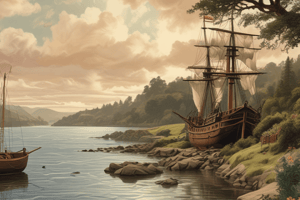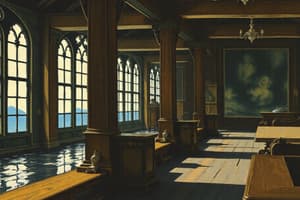Podcast
Questions and Answers
What led to the emergence of new occupations such as masons, carpenters, tailors, painters, and weavers during the medieval period in India?
What led to the emergence of new occupations such as masons, carpenters, tailors, painters, and weavers during the medieval period in India?
- The scarcity of skilled labor
- The decline in traditional occupations
- The demand for luxury items due to the lavish lifestyle of the upper classes (correct)
- The influence of European craftsmen
Why did Bengal become a prominent trading center during the medieval period?
Why did Bengal become a prominent trading center during the medieval period?
- Due to its cotton textile industry (correct)
- A strategic geographical location
- The presence of skilled metalworkers
- The abundance of gold mines
Which city was known as the Gateway to West Asia?
Which city was known as the Gateway to West Asia?
- Surat (correct)
- Masulipatnam
- Bombay
- Madras
What was a significant trade item from Surat mentioned in the text?
What was a significant trade item from Surat mentioned in the text?
What was the significance of Indian silk weavers during the Mughal period?
What was the significance of Indian silk weavers during the Mughal period?
Why was Masulipatnam well-known during the medieval period?
Why was Masulipatnam well-known during the medieval period?
Which European countries established their trading factories and warehouses at Surat?
Which European countries established their trading factories and warehouses at Surat?
What does 'Kalam' and 'Kari' mean in the context of Masulipatnam's kalamkari work?
What does 'Kalam' and 'Kari' mean in the context of Masulipatnam's kalamkari work?
What factor contributed to the decline of Surat according to the text?
What factor contributed to the decline of Surat according to the text?
What was the significance of the English East India Company setting up its first trading post in Masulipatnam?
What was the significance of the English East India Company setting up its first trading post in Masulipatnam?
What type of cloth produced in Masulipatnam was popular in European markets?
What type of cloth produced in Masulipatnam was popular in European markets?
Which century marked the decline of Surat according to the text?
Which century marked the decline of Surat according to the text?
Flashcards are hidden until you start studying
Study Notes
Emergence of New Occupations
- New occupations emerged during the medieval period in India due to the growth of towns and cities, which led to an increase in demand for skilled laborers and craftsmen.
Bengal as a Trading Center
- Bengal became a prominent trading center during the medieval period due to its strategic location on the Ganges River, which provided access to theBay of Bengal and facilitated trade with Southeast Asia and China.
Gateway to West Asia
- The city of Multan was known as the Gateway to West Asia due to its location on the Indus River, which connected India to the Middle East and Central Asia.
Trade Items from Surat
- A significant trade item from Surat mentioned in the text is cotton cloth.
Indian Silk Weavers
- During the Mughal period, Indian silk weavers were highly skilled and renowned for their exquisite silk fabrics, which were exported to Europe and other parts of Asia.
Masulipatnam's Significance
- Masulipatnam was well-known during the medieval period for its thriving textile industry and kalamkari work, a type of hand-painted and block-printed fabric.
European Trading Factories
- The European countries that established their trading factories and warehouses at Surat were the Portuguese, Dutch, and English.
Kalamkari Work
- In the context of Masulipatnam's kalamkari work, 'Kalam' means pen and 'Kari' means craft, referring to the intricate hand-painted designs on fabric.
Decline of Surat
- The decline of Surat was contributed to by the silting of the Tapti River, which made it difficult for ships to access the port.
English East India Company
- The significance of the English East India Company setting up its first trading post in Masulipatnam was that it marked the beginning of European trade and commerce in India.
Popular Cloth in European Markets
- The type of cloth produced in Masulipatnam that was popular in European markets was chintz, a colorful, glazed cotton fabric.
Decline of Surat's Century
- According to the text, the 18th century marked the decline of Surat.
Studying That Suits You
Use AI to generate personalized quizzes and flashcards to suit your learning preferences.




